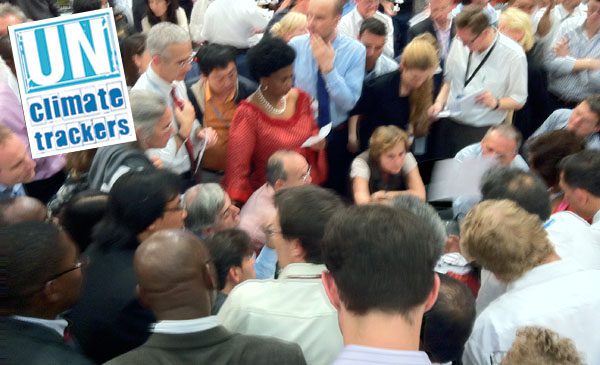
As the Durban climate talks entered into overtime early on Sunday morning, many delegates were sleeping under tables or on desks or chairs, waking occasionally to the sound of people clapping a good speech from a negotiator.
Negotiations seemed at a stand-off, with many countries unhappy with the proposal for the future of the Kyoto Protocol and plans for the long-term direction of a climate agreement. There also was a glaring lack of ambition from countries to reduce their emissions to keep warming below 2 degrees in order to avoid dangerous climate change.
So what was the final result?
Negotiators have narrowly avoided a collapse, agreeing to the bare minimum deal possible. The plan gets the Green Climate Fund up and running but without any sources of funding, preserves a narrow pathway to avoid 4 degrees of warming and gets a second commitment period of the Kyoto Protocol without key members.
After weeks of obstruction from the US, negotiators were unable to identify any concrete and reliable sources of money to fill the Green Climate Fund or ensure that new deeper targets for emissions cuts will be forthcoming.
Governments must now bank the pennies won here in Durban and immediately turn their attention to raising the ambition of their emission reduction targets and filling the Green Climate Fund. Unless countries ratchet up their emissions cuts urgently, we could still be in store for a ten-year timeout on the action we need to stay under 2 degrees of warming.
An important page was turned on discussions of the legal form of a future agreement with the EU, US, Brazil, South Africa, India and China merging towards a common understanding..
Australia, Brazil, South Africa, India and China could have been bolder by joining a coalition of ambition with the EU and vulnerable countries to push for greater and faster emissions reductions. Negotiators may still need to leave the US behind in future talks to pursue the kind of deal that is sorely needed.
Responsibility for the delay in taking the type of action needed to stay within the 2 degree target lies squarely on the shoulders of the US and its supporters such as Australia, Canada and Japan, who dragged their feet from start to finish. While supporting the establishment of the Green Climate Fund, Australia too often was found sitting on the fence and needed to show greater ambition and join the coalition of the willing.
The EU took an important step by signing onto a second period of the Kyoto Protocol, the bedrock of international efforts to fight climate change, and a key demand of African countries. But the new round of Kyoto falls short of what was needed and opens loopholes that weaken it.
The failure to seal an ambitious deal will have painful consequences for poor people around the world. A 4 degree temperature rise could be one of utter devastation for poor farmers who will face increasing hunger and poverty.
If action is not taken, farmers in parts of Africa could face a drop in crop yields of more than fifty percent within this generation or that of their children. Food prices could more than double within the next two decades, up to half of which caused by climate change. This makes delivering real concrete assistance to ensure the most vulnerable people can protect themselves from a changing climate even more vital.
Clancy Moore is blogging from the UN Climate Summit in Durban, South Africa (November 28 – December 9) as part of Oxfam’s UN Climate Tracker project.